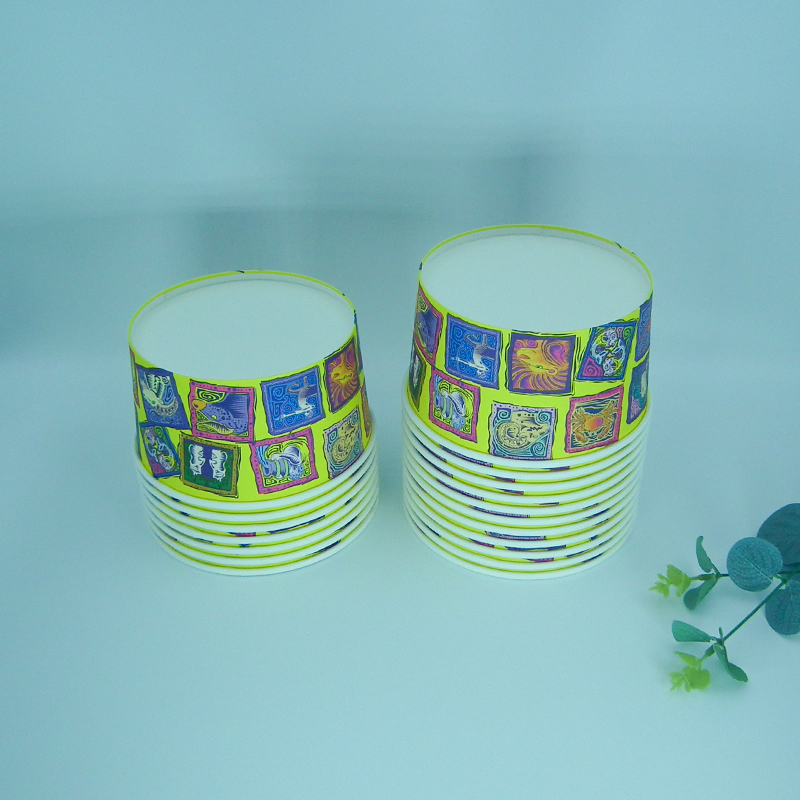
生分解性の持ち帰り用容器とは何ですか?
持ち帰り用容器 が生分解性である理由を説明する前に、まずこの用語自体を理解する必要があります。 「生分解性」は、(微生物の作用により) 徐々に分解してベースの二酸化炭素と水蒸気に戻る製品に割り当てられます。
プラスチックや発泡スチロールの容器は分解するまでに数千年かかる場合があります。その場合でも、より小さな粒子が環境内に残る可能性があります。一方、生分解性容器は完全に分解するまでに短期間しかかかりません。
したがって、生分解性の持ち帰り用容器とは、時間の経過とともに自然に分解できるあらゆる 持ち帰り用食品または飲料の容器 (折り畳み式の箱からコーヒー カップまで) です。
それらは何でできていますか?
生分解性の持ち帰り用容器は、次の素材で作ることができます。
ヘンプ: 大麻植物から抽出されたヘンプは、生分解性が高く、弾力性があり、多用途です。しかし、ヘンプは生分解性製品の原料として高価であるため、商業利用がほとんど見られません。
セルロース: 植物由来のパッケージはセルロースのため分解しやすいです。したがって、短期間のパッケージングには優れたソリューションです。
海藻: セルロースと同様に、海藻ベースの素材は生分解性が高く、短期包装に最適な素材です。
コーンスターチ: コーンスターチはプラスチックのような性質を持っているため、プラスチックや発泡スチロールの代替品として多用途で役立ちます。
PLA: ポリ乳酸 (PLA) はバイオベースであり、従来のプラスチック包装に使用されています。ただし、産業用堆肥化装置内であっても、他の生分解性素材に比べて生分解が遅くなります。
紙: 紙は生分解性包装の伝統的な形式の 1 つです。生分解が早く、リサイクルも簡単です。
バイオフォーム: ポリスチレンに似たバイオポリマーであるバイオフォームは植物性物質から作られ、構造は発泡スチロールに似ていますが、生分解性があるだけでなく、高温下では堆肥化可能です。
キノコ:キノコベースのパッケージは、農業廃棄物を収集し、洗浄して粉末にし、その混合物を菌糸体(菌類の根のような構造)を使用して結合することによって作られます。
こちらもお読みください: 食品包装用のバイオプラスチック
紙 vs バイオプラスチック
紙は、生分解性の持ち帰り用容器を作るのに最も人気のある素材の 1 つです。
しかし、バイオプラスチックは生分解性の持ち帰り用容器の製造に広く使用されると長い間考えられてきました。トウモロコシ、サトウキビ、藻類などの植物から作られるプラスチックです。
環境に優しいと広く宣伝されていますが、その重点の多くは間違いなく石油よりも環境に安全な原材料に重点が置かれています。
生分解性の持ち帰り用容器を作るために紙とバイオプラスチックのどちらを選択する場合は、互いの利点と欠点を考慮する必要があります。
紙:
長所:
リサイクル可能で再利用可能
コスト削減
汎用性 – ニーズに合わせてさまざまな形に成形可能
長期保存可能
短期間で分解する可能性がある
廃棄が簡単
広範囲にわたる可用性
短所:
あまり耐久性がありません
濡れると効果がなくなる
リサイクル率が低い
木材で作られている - つまり森林伐採率が増加している
資源集約的な製造、つまり大量の水を使用するため、水不足や汚染の一因となる可能性があります。
紙の製造にはプラスチックの 4 倍のエネルギーが必要です。
輸送時の二酸化炭素排出量が増加
スタッキングの難しさ
バイオプラスチック:
長所:
農業廃棄物や成長の早い作物を利用できる
長持ちする
高いリサイクル率
軽量
温室効果ガスの排出量が少ない
優れた耐湿性と保持力 - 水ボトルの製造に役立ちます
リソース消費量の少ない生産プロセス
食べ物や飲み物の味に影響を与えにくい
省スペース
短所:
分解速度が遅い
生産コストが高くなる
特別な廃棄プロセスが必要になる場合があります
保存期間が短くなり、損傷しやすくなる可能性があります
数量限定
生分解性の持ち帰り用容器はどのように作られるのでしょうか?
生分解性の持ち帰り用容器の製造方法は使用する材料によって異なりますが、一般的なプロセスは次のとおりです。
梱包材の選択: 最初に、ボール紙からコーンスターチまでの梱包材が選択されます。
原材料の収集: 専用の機械が、生産に使用される原材料の抽出、加工、輸送、保管を監督します。また、粉砕、ふるい分け、粉砕など、材料の最終的な処理にも取り組みます。
製造: 原材料が収集された後、化石燃料から再生可能エネルギーへの切り替えなど、持続可能な製造手法が製造プロセスで使用されます。
ラベル表示: 製造後、生分解性組成を明確にするために容器にラベルが貼られます。
生分解性の持ち帰り用容器の利点
生分解性の持ち帰り用食品容器には、食品業者にとって非常に魅力的ないくつかの利点があります。
プラスチック廃棄物の削減: 生分解性の持ち帰り用容器を使用すると、特にプラスチックとは異なり、環境中で自然に分解されるため、プラスチック廃棄物やポイ捨てが削減されます。
二酸化炭素排出量の削減: 生分解性の持ち帰り用容器は化学薬品やプラスチックではなく生分解性素材で作られているため、大気中への二酸化炭素の放出が少なくなり、二酸化炭素排出量が最小限に抑えられます。
汚染の削減: 生分解性の持ち帰り用容器は、生命の基本物質に分解されるため、環境への汚染物質の放出が少なくなります。
無毒でアレルギーフリー: すべてではないにしても、ほとんどの生分解性素材は、従来の素材と比較して無毒でアレルギーフリーです。
便利な廃棄: 生分解性の持ち帰り用容器は、その組成が完全に分解するのに必要な資源が少ないため、より便利に廃棄できます。堆肥化できるものもあります!
より多くの保管スペース: 生分解性の持ち帰り用コンテナは、従来のコンテナよりも占有スペースが少なく、より多くのスペースを保管できるため、輸送に必要な移動が少なくなります。
持続可能性: 生分解性製品の製造に使用されるほとんどの材料は、持続可能性の 3 つの R、つまりリデュース、再利用、リサイクルに該当します。
多用途性: 生分解性の持ち帰り用容器の材料は、通常、ほとんどの業界で再利用および再利用できます。事務用品の保管から電子機器の梱包まで、環境に優しい素材があらゆるビジネス ニーズを満たします。
運用コストの削減: 生分解性の持ち帰り用容器に投資すると、リソースの使用を減らし、在庫を再利用し、費用対効果の高いリサイクル材料を購入することで、運用コストを削減できます。
ブランドイメージの向上と顧客ベースの拡大: 生分解性の持ち帰り用容器を使用すると、食品供給業者のブランドを強化し、より環境に重点を置いた顧客ベースを引き付けることができます。
生分解性持ち帰り容器の用途と使用法
生分解性の持ち帰り用容器は、環境上の利点と持続可能性によりますます人気が高まっています。その主な用途と用途の一部を以下に示します。
環境に優しい食品サービス: レストラン、カフェ、フード トラックは、環境に責任を持って食品を提供するために生分解性の持ち帰り用容器を使用しています。
イベントケータリング:使い捨て容器が必要だが持続可能性も懸念される屋外イベント、フェスティバル、ケータリングサービスに最適です。
学校やオフィスのカフェテリア: 廃棄物を削減し、学生や従業員の環境に配慮した実践を促進するために、教育現場や企業の現場で採用されています。
食事の準備と配送サービス: 食事の準備会社と食品配達サービスは、生分解性の持ち帰り用容器を利用して、顧客に持続可能な包装オプションを提供しています。
ファーマーズ マーケットと屋台: ファーマーズ マーケットと屋台の販売者は、生分解性の持ち帰り用容器を使用して、生鮮食品や調理済み食品を環境に優しい方法で包装します。
小売食品包装: スーパーマーケットや小売店では、すぐに食べられる食事、サラダ、スナックの包装に生分解性の持ち帰り用容器を採用しています。
パーティーや集まりのための家庭用: 環境に配慮したパーティー、ピクニック、家族の集まりを主催するために、環境に配慮した消費者に選ばれています。
ホスピタリティ産業: 環境への影響を最小限に抑えるために、ホテルやリゾートでルームサービスや室内での食事に採用されています。
航空会社および列車のケータリング サービス: 旅行業界で、飛行機や列車の旅で持続可能な食事パッケージのオプションを提供するために使用されます。
生分解性の持ち帰り用容器はどこで購入できますか?
生分解性の持ち帰り用容器は、レストラン用品店、Amazon や Alibaba などのオンライン マーケットプレイス、環境に優しい製品の専門サプライヤーなど、さまざまな場所から購入できます。
地元の健康食品店やサステイナブル リビング ショップの多くは、環境に配慮した消費者に応えるために、生分解性の包装オプションも提供しています。
よくある質問
生分解性容器とは何ですか?
生分解性容器とは、細菌や他の微生物がすぐに分解できる材料で作られた包装または容器です。
このような容器は通常、コーンスターチ、セルロース、海藻などの植物ベースの材料で作られています。
生分解性とプラスチックの違いは何ですか?
ほとんどのプラスチックは石油を使って作られています。プラスチックは技術的には生分解性ですが、完全に分解するには何百万年もかかり、その後もマイクロプラスチックとして環境中に残ります。
対照的に、生分解性になるように作られた製品は、酸素や水蒸気などの基本成分に完全に分解されるまでに短期間しかかかりません。
生分解性容器がなぜ重要なのでしょうか?
プラスチックや発泡スチロールが環境に与える悪影響を認識する人が増えているため、利便性を損なうことなく環境への影響を軽減するために、多くの飲食店が生分解性の持ち帰り用容器に注目しています。
生分解性の持ち帰り用容器への移行は、より持続可能な産業への重要な変化を表しています。
生分解性の持ち帰り用容器をリサイクルできますか?
使用される素材によって異なります。紙や段ボールの容器はリサイクル可能です。リサイクルが不可能な場合は、代わりに堆肥化するか、自然に生分解させることができます。
生分解性の持ち帰り用容器はどのように処分すればよいですか?
ほとんどの国には、生分解性または堆肥化可能な製品専用のゴミ箱があります。使用済みの生分解性の持ち帰り用容器を処分するときは、生分解性、堆肥化可能かどうかを常に確認することをお勧めします。
リサイクル可能なプラスチックと同様に、生分解性プラスチックと堆肥化可能なプラスチックを混合しないでください。
生分解性の持ち帰り用容器は堆肥化可能ですか?
一部の生分解性製品は堆肥化できますが、すべてが堆肥化できるわけではありません。一般に、紙や段ボールの持ち帰り用容器は簡単に堆肥化できますが、バイオプラスチックなどの他の生分解性製品には特殊な設備とプロセスが必要です。
持ち帰り用の容器が堆肥化可能かどうかを確認するにはどうすればよいですか?
容器の底を見てください。
ほとんどの場合、堆肥化可能な製品にはそのようにラベルが付けられます。従来のリサイクル ロゴが付いている場合は、代わりにリサイクルする必要があります。
容器が堆肥化可能な場合は、製造元に問い合わせることもできます。堆肥化可能な商品のサプライヤーやメーカーは通常、堆肥化可能な商品であることを認識しており、さらに詳しい情報を提供してくれる可能性があります。
持ち帰り用の容器が生分解性かどうかはどうすればわかりますか?
生分解性製品は、最終製品に印刷されたロゴによって認識され、関連する法律で定められたパラメータに従って独立機関によって発行されます。
ただし、確信が持てない場合は、製品が本当に生分解性であるかどうかを判断する最善の方法は、メーカーに電話して、認定された第三者の証明書の発行を依頼することです。
生分解性と分解性の違いは何ですか?
分解性と生分解性の違いを理解する必要があります。
分解性製品は自然分解では分解されません。その代わりに、使用される化学薬品によって材料はどんどん小さく分解され、最後には小さなマイクロプラスチックだけが残ります。
これらのマイクロプラスチックは、動物によって消費される可能性があり、さらにその動物が私たちによって消費され、その結果、連鎖的にさらに蓄積されるため、環境に大きな脅威となっています。
真に生分解性のものは、環境や生物に害を及ぼすことなく、基本製品や物質に完全に分解されます。
生分解性と堆肥化可能の違いは何ですか?
何かが堆肥化可能とラベル付けされている場合、その製品は適切な条件下で堆肥に変えることができます。たとえば、紙製の持ち帰り用容器を基本的な堆肥化容器に入れることができます。
一方、バイオプラスチックのようなものは堆肥化することができますが、専用の施設でのみ使用され、製品がより安全な物質に完全に分解されるように特定の条件とプロセスが使用されます。
これらの物質が適切に処分されなかったと仮定します。その場合、分解するまでに長い時間がかかり(非生分解性材料ほど長くはかからないと思われますが)、大量の温室効果ガスが排出されます。
対照的に、生分解性製品は、適切な時間が与えられれば環境中で自然に分解されます。
生分解性容器は電子レンジで使用できますか?
多くの生分解性容器は高温に耐えるように設計されていますが、ほとんどは電子レンジで使用できるように特別に設計されていません。
そのため、安全のため、食品を生分解性の持ち帰り用容器から電子レンジ対応のボウル、皿、または容器に移すことをお勧めします。
生分解性容器はオーブンで使用できますか?
オーブンで使用できる生分解性容器は、ほとんどのショッピング ウェブサイトで販売されています。
ただし、製品がオーブンに対応しているかどうかを確認するには、製品の説明を確認してください。
テイクアウトの持続可能な未来
生分解性の持ち帰り用容器は、あらゆる飲食業界サービスの未来になりつつあります。そして、価値のある食品業者はすぐにこのワゴンに飛びつくべきであると言っても過言ではありません。
生分解性の持ち帰り用容器はプラスチックを使用しておらず、二酸化炭素排出量が低く、環境に悪影響を与えることなく安全に廃棄できます。また、毒素やアレルゲンも含まれていないため、顧客にとってより健康的な選択肢となります。
さらに、必要なスペースが少なくなり、利用可能なリソースがより有効に活用されるため、将来的には費用対効果の高い投資となる可能性があります。
F&B 店舗を所有している場合は、将来のために生分解性の持ち帰り用容器への投資を検討してください。